Part 1: Evidence and Reflection of My Learning
Outcome 1: Describe the potential of human-centered learning in distributed and open learning contexts
Throughout this course, I read articles, wrote blogs and participated in group communication to meet this learning outcome.
I think the key elements of human-centered learning is to pay attention to students’ individual differences, to teach them according to their aptitude, to protect students’ desire for knowledge and to change teaching methods. Also, I think the “human” in human-centered is not only student-centered, but also includes teacher-centered.
In Topic 1, we read Teaching in blended learning environments: Creating and sustaining communities of inquiry by Vaughan, Garrison and Cleveland-Innes, and discussed blended learning. In this part of the discussion, I argued that with blended learning, there would be less interaction between students and teachers, which might affect the teacher’s attention to the student. My group members gave similar views on this opinion and suggested different solutions.
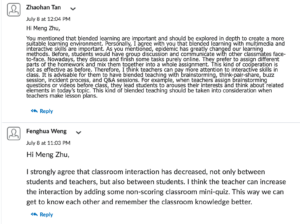
Outcome 2 & 3: Explore and engage with current literature on the distributed and open education movement & Critically reflect on and articulate concepts around modality, pedagogy, and access, including distributed and open learning theory, online and open learning history, privacy laws, online learning communities, open research, and open data.
In topic 1, I read the article Ethical challenges of edtech, big data and personalized learning: twenty-first century student sorting and tracking by Regan and Jesse. I discussed FIPPS-based privacy protection.With the popularity of Internet applications and people’s reliance on the Internet, personal information is under great threat. As a university student, when we use the Internet to study, we should learn to protect our personal information effectively and improve our awareness of Internet security.
Besides that, we also did a FIPPS-related quiz to help us better know how to keep personal information secure.

In week 2, we learned about the difference between distributed learning and open learning
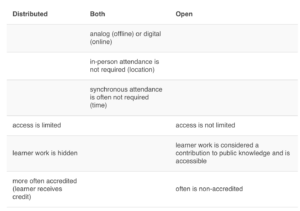
In Topic 2’s article Teaching Online—A Guide to Theory, Research and Practice, I learned about the 5 components of online learning, enrollment, amount, timing, platform and pathway. With the examples of different structured online courses in the article, I also gained a better understanding of several of these elements and showed them in my blog.
In addition, the second week’s article Openness and Education: A beginner’s guide also taught me the concept and history of some words, such as open education, distance education, open education resources and so on, although I did not reflect this part in my blog.
This part of knowledge also helped me with our group assignment. We created a virtual character, Jackson. And our task was to create an effective and appropriate learning program for him based on his personality and reality. During creating the chart, my group members and I compared the similarities and differences between face-to-face, distributed learning, and open learning, and analyzed the impact of different learning styles on Jackson.
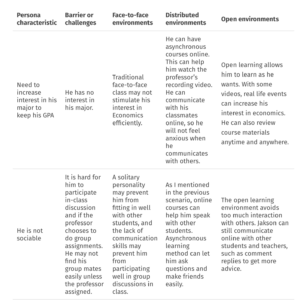
Outcome 4: Examine and reflect upon the potential for equitable access for all learners in online and open learning contexts.
In topic 1, when talking about personal information protection, I pointed out that categorizing students through big data to create personalized learning could lead to the inequity or discrimination. But my group member, Oliver’s response reminded me. About how to ensure equity in learning opportunities, there is no absolute equity. All we can do is combine online and traditional courses to meet the needs of most students.

In topic 3, we read about digital redlining. I found that while digital redlining is effective in protecting students’ online environment, it also restricts students’ freedom of access and creates inequitable access to information. After I read other members’ blogs, I found that Zhaohan Tan had a similar, restricted access experience as I did.
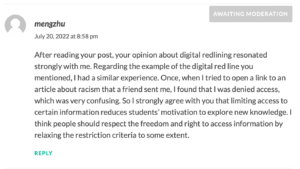
Overall, I argue that learner equity is limited in the context of online and open learning. However, this limitation is not completely negative, as it protects students’ personal information.
Outcome 5: Conduct research into and critically reflect upon emerging and future educational technologies
In the Topic3 article, we got to know what OER is and learned from it the benefits that OER brings. OER providing free and easy access to educational resources for all. However what really made me think deeper was the content of Topic 4. While reading the article, Defining OER-enabled Pedagogy by Wiley and Hilton, especially the part of the article about renewable assignments, it made me connect the reading material to the course itself. My blog has likewise inspired my pod members.
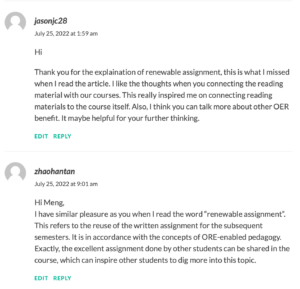
Outcome 6: Practice digital, networked, and open literacies in support of learning about distributed and open learning
Throughout the course,I used various software to achieve this outcome.
In the first week, we used LMS platform, Brightspace to discuss. We introduced ourself, and took quiz.

After Topic 1, we post our thought on WordPress, which is an open learning platform, everyone can view your blogs and comment. It’s also a shift from distributed learning to open learning.
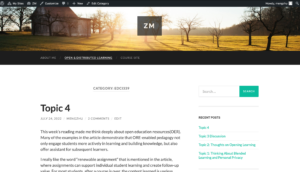
Communication with group members is done through Mattermost and Discord. We share our blogs and discuss group assignment on it.
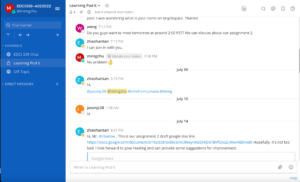
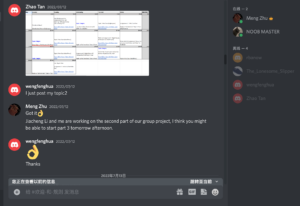
We also used google doc to write our group assignment.

Part 2: Showcase
Link to updated version of the post: https://zmjudy.opened.ca/topic-3-open-edu…l-reading-update/
Link to the original version of the post: https://zmjudy.opened.ca/topic-3-discussion/
The changes made along with reasons why the changes were made:
Firstly, I corrected the spelling errors in the original blog. e.g. ORE -> OER
Then, regarding the OER section of the blog, I added the concepts and characteristics of OER, as well as relevant examples. After reading the comments on the original blog, I added a description of how OER can help students contribute knowledge.
About the section on digital redlining, Weng’s comment gave me new ideas. So I rethought the impact of digital redlining on non- university students.
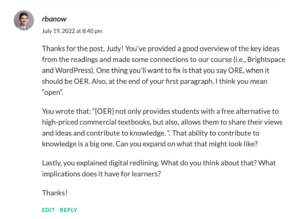

References
Gilliard, C., & Culik, H. (2016, May 24). Digital Redlining, Access, and Privacy. Common Sense Education.
Jordan, K. & Weller, M. (2017). Openness and Education: A beginners’ guide. Global OER Graduate Network.
Major, C. H. (2015). Teaching Online – A Guide to Theory, Research, and Practice. Retrieved from http://ebookcentral.proquest.com/lib/uvic/detail.action?docID=3318874 (pp. 76-108)
Mays, E. (Ed.). (2017). A guide to making open textbooks with students. Rebus Community.
Morris, S. M., & Stommel, J. (2018). An urgency of teachers: The work of critical digital pedagogy. Hybrid Pedagogy.
Regan, P., & Jesse, J. (2019). Ethical challenges of edtech, big data and personalized learning: Twenty-first century student sorting and tracking. Ethics and Information Technology, 21(3), 167-179. DOI: 10.1007/s10676-018-9492-2
Wiley, D. & Hilton, J. (2018). Defining OER-enabled Pedagogy. International Review of Research in Open and Distance Learning, 19(4).













